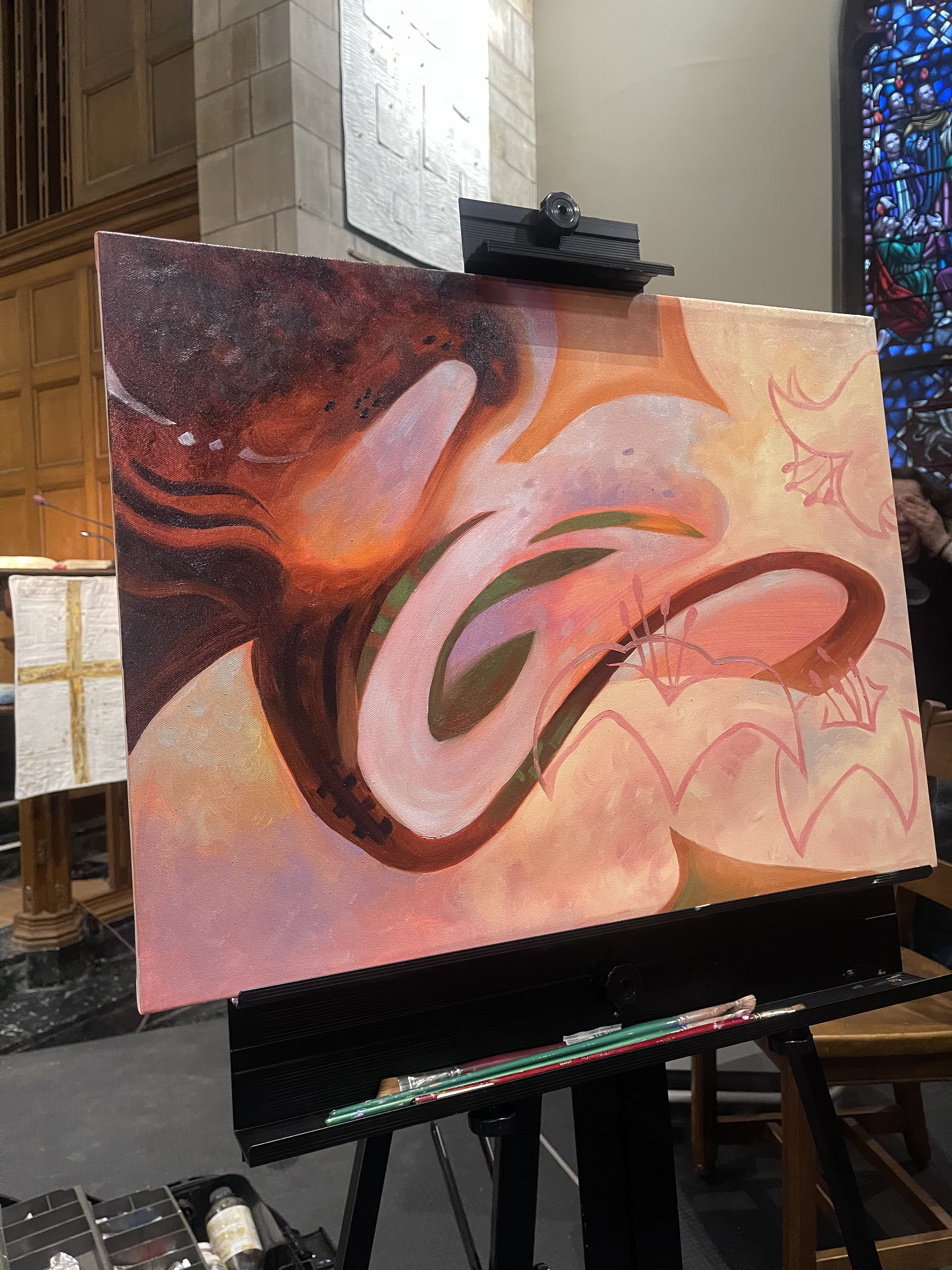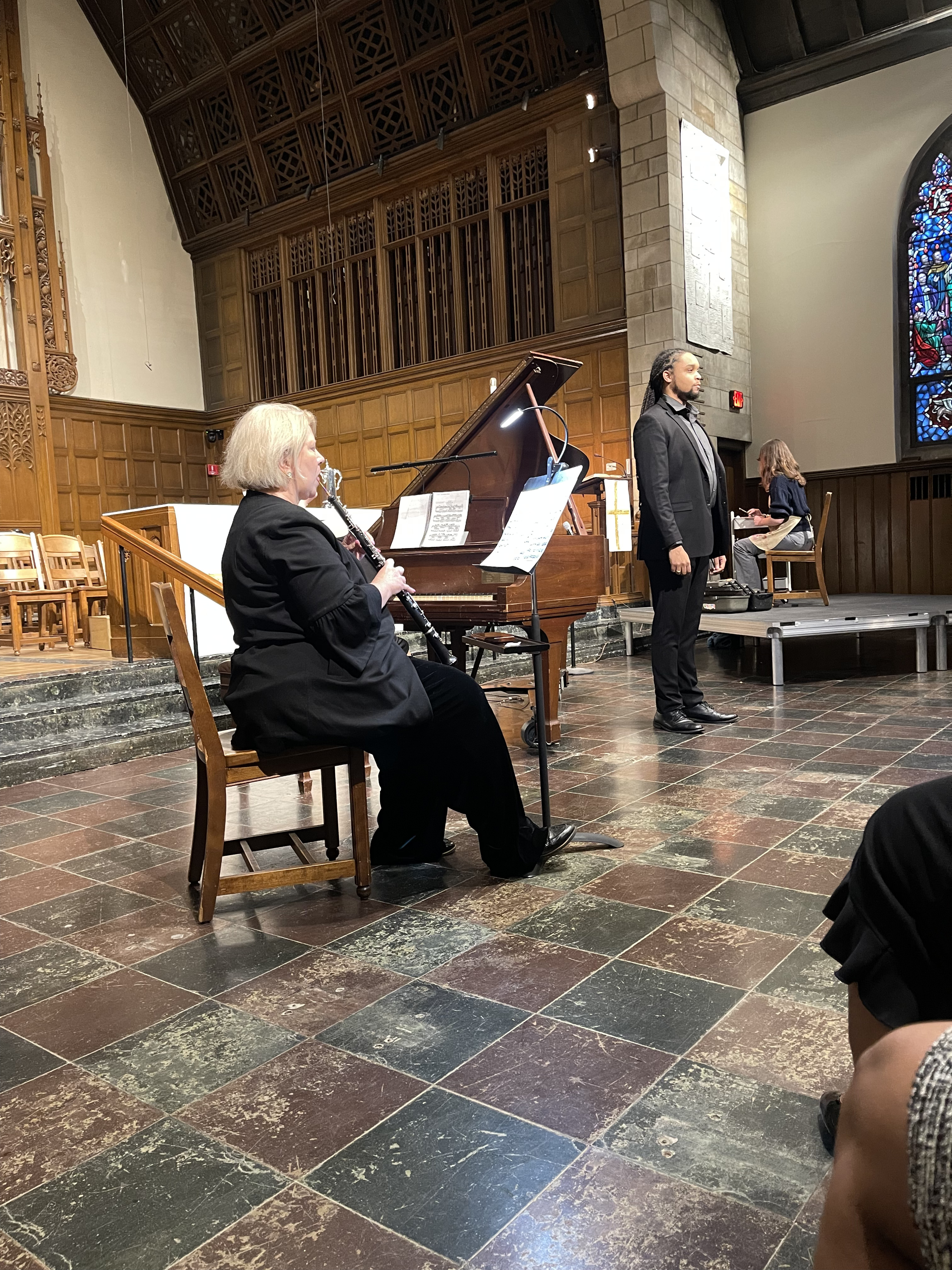The project that I created was for my dissertation recital series called Footprints. Specifically, I used one of the recitals in the series to survey colleagues and how they felt before,
during, and after the recital to explain music’s impact on the sensorium. Investigating the performance and reception of sacred texts illuminates how messages of faith and hope can positively affect individuals facing mental health challenges, such as anxiety
and depression. Recognizing that affirmations foster inner strength, courage, and determination
in people, we musicians, particularly singers, must connect deeply with the lyrics to deliver that
hope. Sacred texts that convey themes of a higher power and a more promising future resonate
with the soul, facilitating a meaningful contribution from both the performer and the audience to
the broader societal context. Traditional and contemporary composers have employed sacred
texts and the structure of sacred services as vehicles to affirm a deeper truth amid dire
circumstances. This research will enhance scholars' and performers' comprehension of how the
potency of words, particularly sacred texts, reinforces human connection and reality in an
increasingly technological world.

The second installment of the recital series is divided into three sections that I have
labeled: Songs of Prayer, Songs of Hope, and Songs of Faith and Affirmation. Within each
distinct section, I have placed songs that align with these themes, either because of the text, the
history, or the emotional intent of the piece as conveyed by the composer’s music. I have also
chosen to include a painter for this recital as an added component of interdisciplinary
partnership, expanding how music impacts the sensorium of the audience and other art forms.
Reese Ford, a junior at the University of Michigan, created a piece she titled “Prayer” as a
commissioned work for this recital. Upon hearing the pieces from the recital for the first time,
she crafted this artwork to illustrate how the text and sound of music can be represented on a
canvas, enhancing the reach, power, and impact of sound within the sensorium. It is my hope that
the audience will be immersed in an environment where the visual and auditory come together to
create an experience that inspires the theme of the recital.
The works in the Songs of Prayer are characterized as prayers. The pieces in this section
include “Ich habe genug” by Bach, “Vergin tutto amor” by Durante, “En Prière” by Fauré, “It Is
Enough” by Mendelssohn, and the “Vier ernste Gesänge” by Brahms. Each of these pieces has a
different emotional weight and was created with specific ideas in mind; however, they all convey
lamentation or a conversation with a higher being. In many religious settings, prayers often draw
upon biblical texts and characters who are lamenting or struggling and need intercession. In this
section, the lamenting biblical characters are Jesus in “En Prière” and Elijah in “It Is Enough.”
Both characters find themselves at the end of their strength and choose to pray to God for
support. Knowing that prayer is a biblical principle, “Vergin tutto amor” relies on a plea to the
Virgin Mary for intercession. Although this piece is not explicitly mentioned in the Bible, its
sacredness lies in its association with the Virgin Mary, a revered figure in the Catholic faith.
Bach’s piece is inspired by the biblical character Jesus, as the singer enters a state of praise upon
realizing what they have just encountered by seeing and holding Jesus. This piece serves as a
prayer of assurance, suggesting that they can move on, even to death, because the prophecy has
been fulfilled, allowing for rest. Lastly, the “Vier ernste Gesänge” song cycle emerged from
lamentation. Brahms was mourning the loss of Clara Schumann, and one of the ways he coped
emotionally was through his music. He drew passages from the Bible to understand life and
death, which he achieved musically in the cycle. For him, as a non-religious man, he turned to
sacred texts to explore his feelings, representing another form of prayer.
Engaging in a conversation with oneself or a higher power to seek understanding and deeper truths serves as a
method of prayer, exemplified by Brahms in his final song cycle out of three.
The pieces in the Songs of Hope are all spiritual arrangements. One of the genres
developed during the period of enslavement was called the spiritual. This particular genre of
music embodies the essence of endurance and hope. Those who were enslaved overheard parts of
biblical narratives from their masters and transformed the stories into songs that helped them
overcome difficult times. Many of these pieces served as coded messages and work songs, aiding
the escape of the enslaved and helping them endure. The arrangements in this recital instill hope,
as the text suggests that a higher power will deliver the enslaved from oppression and trouble
along life’s tumultuous journey.
In this last section, called Songs of Faith and Affirmation, songs based on sacred texts
and principles are presented within a different genre. Typically, we find many classical pieces
with sacred texts, but do not realize the connections that other genres have with the sacred. For
instance, Duke Ellington, a prominent jazz musician and composer, created sacred concerts that
included music about a higher power, and one of those pieces is in this set called Come Sunday.
Beyond jazz, the evolution of the spiritual eventually led to Gospel music, which is also
represented here. All music, regardless of genre, serves as a profession of faith and affirmation.
The style or genre does not diminish the belief that one has in a truth, and it will be apparent that
the text will speak louder than any socially constructed genre. Faith and affirmation are ways in
which human beings can continue to thrive when all seems lost. Speaking, hearing, and believing
in positive messages and truths will allow our community and culture to live with joy, peace, and
light.
I had the opportunity to survey a few of my colleagues, and their findings helped advance
my ongoing research into the role of positive affirming texts in our daily lives, as well as how
music functions as a conduit for positive messaging. Engaging in discussions with my colleagues
about the recital and their emotional responses allowed me to document this information and
adapt these findings for future recitals and concert programming. The conversation and survey
included questions about individuals' emotional states before, during, and after the recital, as
well as how the music helped them overcome their current emotional challenges and reach a
better emotional state. Since completing my recitals, I have been working to expand the survey
within the framework of A Sacred Music Festival, which I am producing in Washington, D.C. I
plan to use the same questions on a larger scale, enabling me to continue providing positive and
affirming programming when the world and community feel emotionally overwhelmed. The
support during my library consultations pointed me in the right direction to effectively gather
data for my research. Also, it introduced me to different surveying tools that will help me collect
information more efficiently. As I move forward, I plan to utilize the insights gained from
consultations, conversations, and surveys to develop programming in the DC area that is
impactful and helps community members find hope through music.
